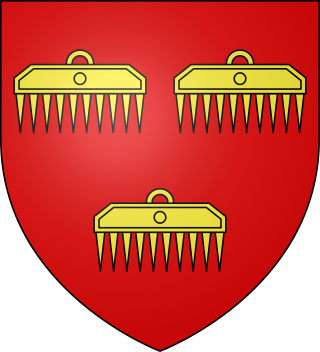Albret dynasty

- John of Albret (1491–1500; also lord of Orval; married Charlotte of Rethel)
- Marie of Albret (1500–1549)
The first rulers of Rethel might have governed under the Abbey of Saint-Remi and later independently, before the county passed first to the counts of Nevers, then to the counts of Flanders, and finally to the dukes of Burgundy. In 1405 the county became part of the peerage of France, and in 1581 it was elevated to a duchy. In 1663 it became the Duchy of Mazarin.
The county was active in the crusades. King Baldwin II of Jerusalem was the brother of Count Gervais and Countess Matilda of Rethel, while Beatrice of Rethel married Leo I, Prince of Armenia.

Nowadays, the title is still claimed by her descendants, the Sovereign Princes of Monaco.

The Capetian House of Valois was a cadet branch of the Capetian dynasty. They succeeded the House of Capet to the French throne, and were the royal house of France from 1328 to 1589. Junior members of the family founded cadet branches in Orléans, Anjou, Burgundy, and Alençon.

Philip II the Bold was Duke of Burgundy and jure uxoris Count of Flanders, Artois and Burgundy. He was the fourth and youngest son of King John II of France and Bonne of Luxembourg.

Philip of Rouvres was the Count of Burgundy and Count of Artois from 1347, Duke of Burgundy from 1349, and Count of Auvergne and Boulogne from 1360. He was the only son of Philip, heir to the Duchy of Burgundy, and Joan I, heiress of Auvergne and Boulogne.

Anthony, Duke of Brabant, also known as Antoine de Brabant, Antoine de Bourgogne and Anthony of Burgundy, was Count of Rethel (1402–1406), Duke of Brabant, Lothier and Limburg (1406–1415), and Co-Duke of Luxemburg (1411-1415). He was killed at the battle of Agincourt.

Margaret III was a ruling Countess of Flanders, Countess of Artois, and Countess of Auvergne and Boulogne between 1384 and 1405. She was the last Countess of Flanders of the House of Dampierre.
The counts of Nevers were the rulers of the County of Nevers, in France, The territory became a duchy in the peerage of France in 1539 under the dukes of Nevers.
The count of Artois was the ruler over the County of Artois from the 9th century until the abolition of the countship by the French revolutionaries in 1790.

The Burgundian Netherlands were those parts of the Low Countries ruled by the Dukes of Burgundy during the Burgundian Age between 1384 and 1482. Within their Burgundian State, which itself belonged partly to the Holy Roman Empire and partly to the Kingdom of France, the dukes united these lowlands into a political union that went beyond a personal union as it gained central institutions for the first time.

This is a list of the counts of Eu, a French county in the Middle Ages.

Louis II, also known as Louis of Male, a member of the House of Dampierre, was Count of Flanders, Count of Nevers, and Count of Rethel from 1346 to 1384, and also Count of Artois and Count of Burgundy from 1382 until his death. He was the son of Count Louis I of Flanders and the Countess of Burgundy and Artois, Margaret I of Burgundy, the youngest daughter of the King of France, Philip V the Tall.

Phillip II, Count of Nevers was the youngest son of Philip the Bold and Margaret III of Flanders.

Margaret I was a Capetian princess who ruled as Countess of Burgundy and Artois from 1361 until her death. She was also countess of Flanders, Nevers and Rethel by marriage to Louis I of Flanders, and regent of Flanders during the minority of her son, Louis II, in 1346.

John II, Count of Nevers was a French noble.

The House of Valois-Burgundy, or the Younger House of Burgundy, was a noble French family deriving from the royal House of Valois. The Valois-Burgundy family ruled the Duchy of Burgundy from 1363 to 1482 and eventually came to rule vast lands including Artois, Flanders, Luxembourg, Hainault, the county palatine of Burgundy (Franche-Comté), and other lands through marriage, forming what is now known as the Burgundian State.

Anne of Armagnac, Dame d'Albret, Countess of Dreux was a French noblewoman and a member of the powerful Gascon Armagnac family which played a prominent role in French politics during the Hundred Years War and were the principal adversaries of the Burgundians throughout the Armagnac-Burgundian Civil War. Anne was the wife of Charles II d'Albret.

The House of Dampierre played an important role during the Middle Ages. Named after Dampierre, in the Champagne region, where members first became prominent, members of the family were later Count of Flanders, Count of Nevers, Count of Rethel, Count of Artois and Count of Franche-Comté.

Ermentrude de Roucy (Irmtrude) was a Countess and Duchess of Burgundy.

The County of Rethel, promoted to Duchy of Rethel in 1581 and finally the Duchy of Mazarin after 1659, was a historic county in the French region of Ardennes. Its capital was the city of Rethel. The duchy was abolished due to the French Revolution in 1789.